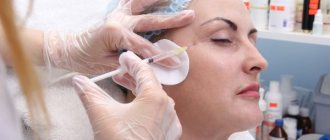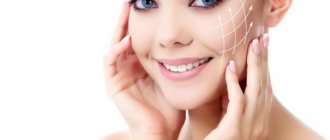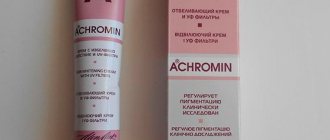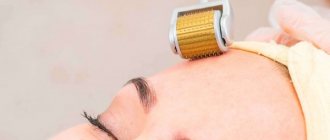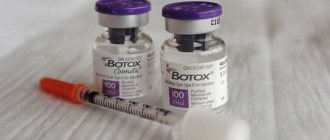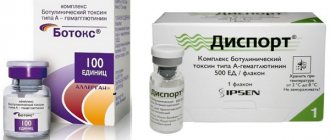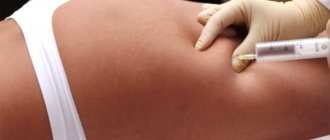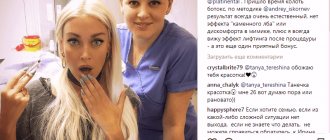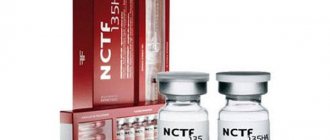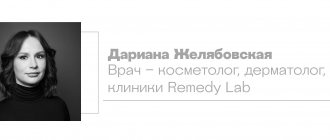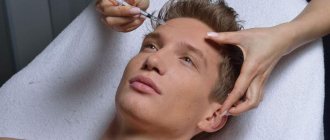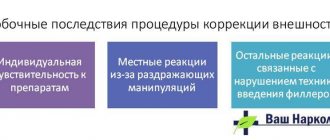Features of the drug
Dysport is produced in France by the pharmaceutical company Beaufour Ipsen Pharma and in the UK under the supervision of French colleagues. The use of Dysport injections in cosmetology has been used for more than 20 years.
The drug contains the following components:
- hemagglutinin type A (otherwise botulinum toxin);
- human albumin;
- lactose.
Botulinum toxin is a highly toxic substance obtained from bacteria of the genus Clostridium botulinum. The component has a paralytic effect on the nervous system and, when used correctly, blocks some overly mobile areas of muscle structures. Inappropriate use may cause botulism infection.
For cosmetic purposes, doctors use an insignificant amount of toxin, which does not affect systemic processes in the body and cannot provoke serious complications.
The mechanism of operation of the substance is to stop nerve impulses supplied to the muscle channels with the subsequent loss of their contractility. The activity of muscle receptors decreases until the end of the drug's effect.
The duration of the paralytic effect varies from 6 to 12 months depending on the injection area.
Important! With the help of neuroparalytic injections, sweating, headaches, ophthalmological diseases, and disruption of nerve impulses to muscle structures are successfully treated.
Widely used in pediatric practice for the treatment and prevention of foot deformities in cerebral palsy.
Reviews
If you still don’t believe in the effectiveness of Dysport injections, be sure to read the reviews of clients who have tried these procedures on themselves.
Anastasia, Tula
“My friends are afraid to use this drug to correct their problems, because they are afraid that it contains some kind of toxin. However, I regularly use the drug "Dysport", and so far nothing bad has happened to me. On the contrary, my face looks just like it did when I was younger!
It is important, of course, to choose a qualified specialist. I sometimes had side effects, but they went away on their own after a few days. There was swelling or bruising where the needle entered.
At first, I couldn’t decide on a specific procedure that would help me rejuvenate my skin. I studied a lot of information, looked at “before” and “after” photos of clients on the Internet. And it was Dysport that impressed me most.
For the past four years I have been systematically turning to my cosmetologist to give me injections. It’s a pity that I didn’t know about this drug before, because I could have protected myself from many problematic wrinkles. Although at my age the effect of the drug is pleasing.”
Patients are satisfied with the results of the procedure
Alena, Ivanovo
“I tried Dysport and was very pleased with the result! If you still doubt whether you need these injections, cast aside your doubts and go to a cosmetologist!
The effect of the drug is simply magical: I forgot about wrinkles, my skin became elastic. You can look at before and after photos of women - you will be surprised. I waited half a month after the injection - and there were no more wrinkles around the eyes and on the forehead.
I feel really beautiful, men look at me and say nice words. But it’s compliments that make a woman happy! In general, I'm satisfied. I’ll definitely repeat the procedure in six months.”
If the procedure is carried out correctly, the effect will be stunning.
Ekaterina, Astrakhan
“Every woman is afraid of old age. On my table I have collected a whole collection of various skin care products - masks, creams and much more. Alas, all this cosmetics did not save me from annoying wrinkles.
Not long ago I came across information about the drug “Dysport” on the Internet, read the videos and photographs, and looked at the reviews. I found out that even at my age you can get injections. In general, a break from a lot of information, I decided to go to a cosmetologist.
I was looking for a good clinic for a very long time. After all, if you come across a low-quality drug or a bad specialist, then you will have a very long time to solve the problems. The cosmetologist at my clinic told me about the procedure in every detail.
The effect made me very happy. Now I have almost no wrinkles, I no longer wrinkle my forehead and live peacefully. My husband, who “sponsored” my trip to the cosmetologist, is also pleased with the result. Be sure to try this procedure if you also have wrinkles! I even stopped always frowning and seeming dissatisfied. Thus, the injections are worth the money spent on them (especially since the amounts are not exorbitant).”
Advantages
Dysport injections have several advantages over alternative drugs with similar effects on nerve impulses. Thus, when compared with Botox, Dysport has a more intense and prolonged effect, which significantly affects the patient’s budget.
Other benefits are:
- Instant results. The effect after the procedure is noticeable after 1-2 days. This advantage gives women the opportunity to quickly rejuvenate before an important event.
- Long lasting effect. The result after injection therapy lasts up to six months. If it is necessary to preserve youthful skin for 1-1.5 years, it is necessary to administer 2-3 injections of the drug.
- Delayed action. A special feature of the drug is a gradual increase in the effect of the drug, which is noted after each botulinum therapy session. Already 3 years after the start of correction, 2-3 injections per year will be enough.
- Neurotoxic effect. The rapid effect is explained by the high content of toxic compounds in the drug. Despite this, the activity of Dysport is slightly lower than Botox. So, 4 units of Dysport are equivalent to 1 unit of Botox. Therefore, the capacity of Dysport is larger, which is reflected in the price.
- Depth of impact. The degree of penetration into the subcutaneous and muscular structures reaches 3 cm. This exceptional feature is also a disadvantage due to the occurrence of intense painful sensations, tissue drooping and a feeling of aching muscles.
The neuroparalytic effect of Dysport injections can spread to other parts of the face, close to the injection area.
The albumin used in the manufacture of the drug is a preservative and can affect the development of swelling and the occurrence of allergic reactions.
Anti-aging product price
The cost of a rejuvenating procedure directly depends on the number of injections required to achieve a cosmetic result, as well as the complexity of the work. On average, a session for smoothing wrinkles and relaxing muscles in a state of hypertonicity costs 4,500-8,000 rubles.
Reviews from patients and cosmetologists who have used the drug Dysport indicate a positive result in rejuvenation of the face and all parts of the body. This product contains botulinum neurotoxin, the concentration of which is safe for the human body.
The local action of injections ensures the local activity of the drug without its penetration into the blood and tissues of internal organs. Dysport is indicated for women over 30 years of age who are faced with the problem of facial wrinkles, impaired facial symmetry, and sagging skin.
Indications for use
Injection cosmetology belongs to the category of minimally invasive manipulations that require compliance with rules, indications and other special instructions for use.
Dysport injections are used in cosmetology practice in the following cases:
- the appearance of deep eyebrow wrinkles;
- horizontal wrinkles on the forehead:
- fine wrinkles around and under the eyes;
- drooping eyebrow line;
- aging of the neck and décolleté;
- excessive activity of the facial muscles.
Using the product, you can tighten your cheeks and make your cheekbones more expressive. With pronounced asymmetry, you can significantly improve the appearance and equalize individual parts of the face. Experts recommend Dysport injections for patients with dry, sensitive skin.
What kind of drug this is, how it works and to whom it is indicated is described in more detail in the video.
Restrictions and prohibitions after Dysport beauty injections
Dysport injections are safe and involve minimal risks that may arise after the rejuvenation session is completed.
Over the next 2 weeks, it is recommended to adhere to the following rules , which will ensure the fastest possible restoration of the skin and muscle tissue of the face, as well as other parts of the body:
- avoid hypothermia of the skin where the drug was injected;
- avoid injury and compression of epithelial tissues;
- balance your diet;
- monitor the hygiene of the face, neck, and décolleté;
- do not drink alcohol and drugs, as they weaken the immune system;
- exclude swimming in open reservoirs and public pools;
- For 3 days after performing the rejuvenating procedure, stop using cosmetics.
All instructions from the cosmetologist regarding the recovery period are required to be followed. This will eliminate the likelihood of complications and accelerate the complete recovery of epithelial tissues, smooth out wrinkles, relieve swelling and inflammation.
Basic prohibitions
The presence of potent toxins in Dysport can be harmful to patients with a burdened clinical history when there are serious functional disorders of organs or systems.
Before performing the procedure, the doctor must make sure that there are possible contraindications:
- eye pathologies (myasthenia gravis, cataracts);
- low blood clotting ability;
- lung diseases;
- infectious diseases of any nature in the acute period;
- pregnancy and lactation;
- early age up to 18 years;
- inflammation in the area of intended injection (pimples, acne, boils, etc.);
- epilepsy attacks;
- oncological formations of any genesis and localization;
- allergic reactions to the constituent components of the drug.
Despite its simplicity and short duration of the procedure, the drug can cause a wide variety of reactions from the body’s immune system.
In the presence of various complications, the reaction can be unpredictable and irreversible.
Contraindications
Before the procedure, you must carefully read the contraindications.
Temporary: pregnancy or breastfeeding, infectious diseases, use of certain medications (for example, antibiotics), childhood (up to 12 years).
Permanent: negative reaction to the drug used, blood diseases, chronic diseases associated with the respiratory system.
The drug has contraindications
Important! If you have ever had a severe allergy to protein drugs, you should definitely inform your specialist.
Administration zones
Mostly, Dysport injections are used to correct age-related changes in the upper part of the face. The drug is not used in concentrated form. Before administration, it is diluted with sodium chlorine (0.9% solution).
A single area for treating the upper part of the face should not exceed 150-200 units of the drug. The main injection areas include:
- Frontal zone. Deep and fine horizontal wrinkles are eliminated on the forehead. The correction procedure includes up to 6 injections of Dysport.
- Interbrow area. Vertical creases often appear in this area, and the appearance of the face becomes gloomy and sad. To determine the localization of the injection, maximum muscle tension in the space between the eyebrows is required. Correction is carried out in 2-4 injections.
- Bridge of the nose. A small number of small wrinkles are localized on the back of the nose, which also affect a woman’s appearance. For correction, it is enough to designate 2 points of intended injection.
- Area around the eyes. The injection is administered into the area of the outer corners of the eye, distributing the drug with the fingers immediately after the injection under the eyes. Before administration, the doctor determines 3-4 points in the area of the literal eye muscle.
The décolleté area, neck and back of the hands are less often corrected with Dysport, but if necessary, the doctor similarly selects the necessary injection points and performs cosmetic manipulation.
Poison in the service of beauty: how Dysport works
The facial muscles, which receive the brain signal to move, are attached to the skin at one end. When expressing emotions and in conversation, the muscles contract, thus forming facial movements. At a young age, human skin is so elastic that the skin grooves and folds, called wrinkles, smooth out on their own. As a person gets older, the skin tone decreases and the manifestations of a person’s emotions, expressed in facial expressions, form wrinkles that can no longer be smoothed out on their own.
photo from www.bostoneveningtherapy.com
This is where products containing botulinum toxin come to the rescue. One of the brightest representatives of this group of drugs is Dysport. It consists of a type A neurotoxin, in other words, a neuroparalytic poison, which paralyzes the facial muscles, preventing the signal coming from the brain from acting on facial expressions. Even in low concentrations, neurotoxin type A blocks the action of acetylcholine, which is responsible for muscle contraction. The concentration of poison in Dysport is so low that, if used properly, it is not capable of causing harm to the body. If the procedure is carried out correctly, the consequences of Dysport in the photo will certainly please you: smoothing out the wrinkles on the forehead and in the corners of the eyes will immediately erase ten years from the face.
Recommended Doses
The dosage for administration to different areas of the face differs according to many criteria, for example, the thickness of the skin, the severity of the relief, the structure of the skin, its quality.
When administered to certain areas, doctors are guided by the following permissible doses:
- Between the eyebrows. The volume of the drug varies from 40 to 42 units.
- Frontal zone. The medicine is administered 1.5-2 cm above the eyebrow line. The permissible dose is no more than 90 units.
- Crow's feet or wrinkles around the eyes. The injection site is determined by a distance of 2 cm to the ear and a dosage of no more than 120 units on both sides.
Treatment of facial muscle structures begins with minimal therapeutic doses. With the following procedures, you can slightly increase the dosage.
After some time, the interval between courses of injection correction can be increased to 8-9 months.
Popular fillers for correcting nasolabial folds and procedure. Read here about the effectiveness of Blepharogel for bags under the eyes.
At this address https://cosmetolog-expert.ru/plastika-litsa/feyslifting/inektsii/biorevitalizatsiya-ial-sistem.html you will find reviews from cosmetologists about Ial biorevitalization systems.
Dysport®
General recommendations
Recommended doses of Dysport® 500 IU are drug-specific and are not interchangeable with other botulinum toxin A preparations;
Dysport® 500 units should be administered by specialists trained in the administration of treatment.
Focal spasticity of the upper limbs in adults
The maximum total single dose should not exceed 1000 units.
When treating focal spasticity of the upper extremities, Dysport® is diluted to a concentration of 100 U/ml, 200 U/ml or 500 U/ml (see Table 5). The drug is used as intramuscular injection according to the scheme given below.
Dosage during initial and subsequent treatment sessions should be individualized and based on the size, number and location of muscles involved, degree of spasticity, presence of local muscle weakness, patient response to previous treatment and/or history of adverse events during treatment with botulinum toxin complex type A - hemagglutinin.
In clinical studies, doses of 500 IU and 1000 IU were distributed among the muscles involved in the injection session and are indicated in the table below.
The number of injection points depends on the volume of muscles into which injections will be made.
No more than 1 ml of solution can be injected into one point.
Table 1. Dosage of Dysport® for the treatment of focal spasticity of the upper limbs by muscle
| Injected muscles | Recommended doses of Dysport® (IU) |
| Flexor carpi radialis (m. flexor carpi radialis (FCR)) | 100-200 |
| Flexor carpi ulnaris (m. flexor carpi ulnaris (FCU)) | 100-200 |
| Flexor digitorum profundus (m. flexor digitorum profundus (FDP)) | 100-200 |
| Flexor digitorum superficialis (m. flexor digitorum superficialis (FDS)) | 100-200 |
| Flexor pollicis longus (m. flexor pollicis longus ) | 100-200 |
| Adductor pollicis muscle (m. adductor pollicis ) | 25-50 |
| Brachialis (m. brachialis ) | 200-400 |
| Brachioradialis muscle (m. brachioradialis ) | 100-200 |
| Biceps brachii (m. biceps brachii ) | 200-400 |
| Pronator teres (m. pronator teres ) | 100-200 |
| Triceps brachii (m. triceps brachii ) long head | 150-300 |
| Pectoralis major muscle (m. pectoralis major ) | 150-300 |
| Subscapularis muscle (m. subscapularis ) | 150-300 |
| Latissimus dorsi (m. latissimus dorsi ) | 150-300 |
Although the immediate injection site is determined by palpation, it is recommended to use standard determination techniques such as electromyography, electrical stimulation or ultrasound to select the injection site.
Repeated injections of Dysport® should be carried out after the effect of the previous injection has subsided, but not earlier than after 12 weeks. Most patients in clinical studies received repeat injections after 12 to 16 weeks; however, some patients had a longer effect - up to 20 weeks. The degree and pattern of muscle spasticity at the time of repeat injection may require changes in the dose of Dysport® and the muscles being injected. Clinical improvement can be expected a week after injections of Dysport®.
Elderly patients (≥ 65
years)
: clinical experience has not shown differences in response between elderly and younger patients. Elderly patients should be evaluated for tolerance to botulinum toxin type A due to the high incidence of comorbidities and other drug therapies.
Focal spasticity of the lower extremities in adults
During one treatment session, a dose of up to 1500 units can be administered intramuscularly.
When treating focal spasticity of the lower extremities, Dysport® is diluted to a concentration of 100 IU/ml, 200 IU/ml or 500 IU/ml (see Table 5). The drug is used as intramuscular injection according to the scheme given below.
Dosage for initial and subsequent treatment sessions should be individualized and based on the size and number of muscles involved, the degree of spasticity, the presence of local muscle weakness and the patient's response to previous treatment. In clinical studies, doses of 1000 IU and 1500 IU were distributed among the muscles involved in the injection session and are indicated in the table below.
No more than 1 ml of solution can be injected into one point.
Table 2. Dosage of Dysport® for the treatment of focal spasticity of the lower extremities by muscle
| Muscle | Recommended dose range for muscle (IU) | Number of injection points per muscle |
| Main target muscles | ||
| Soleus muscle (m. soleus ) | 300-550 units | 2-4 |
| Calf muscle (m. gastrocnemius ) | ||
| Medial head | 100-450 units | 1-3 |
| Lateral head | 100-450 units | 1-3 |
| Distal muscles | ||
| Tibialis posterior muscle (m. tibialis posterior ) | 100-250 units | 1-3 |
| Flexor digitorum longus (m. flexor digitorum longus ) | 50-200 units | 1-2 |
| Flexor digitorum brevis (m. flexor digitorum brevis ) | 50-200 units | 1-2 |
| Flexor pollicis longus (m. flexor hallucis longus ) | 50-200 units | 1-2 |
| Flexor pollicis brevis (m. flexor hallucis brevis ) | 50-100 units | 1-2 |
| Proximal muscles | ||
| Rectus femoris (m. rectus femoris ) | 100-400 units | 1-3 |
| Muscles of the back of the thigh (hamstring ) | 100-400 units | 1-3 |
| The adductor magnus muscle of the thigh (m. adductor magnus ) | 100-300 units | 1-3 |
| Adductor longus femoris (m. adductor longus ) | 50-150 units | 1-2 |
| Adductor brevis muscle (m. adductor brevis ) | 50-150 units | 1-2 |
| Gracilis muscle (m. gracilis ) | 100-200 units | 1-3 |
| Gluteus maximus ( m. gluteus maximus ) | 100-400 units | 1-2 |
The degree and pattern of spasticity may change at the time of reinjection, which may require adjustment of the dose of Dysport® and selection of target muscles. Although the immediate injection site is determined by palpation, it is recommended to use standard determination techniques such as electromyography, electrical stimulation or ultrasound to select the injection site.
Repeated injections of Dysport® are carried out every 12-16 weeks or less frequently, based on the return of clinical symptoms, but not earlier than 12 weeks after the previous injection.
Focal spasticity of the upper and lower extremities in adults
If it is necessary to treat spasticity of the upper and lower extremities during one treatment session, the dose of Dysport® for injection into each extremity should be adapted to individual needs and should not exceed a total dose of 1500 units.
Elderly patients (≥
65 years)
: clinical experience has not shown differences in response between elderly and younger patients. Elderly patients should be assessed for tolerance to Dysport® due to the high incidence of concomitant diseases and therapies with other drugs.
Focal spasticity of the lower extremities in children aged 2 years or older
When treating focal spasticity of the lower extremities in children, Dysport® is diluted to obtain the required concentrations in accordance with Table 5. The drug is used for intramuscular injection according to the scheme given below.
Initial and subsequent doses during injection sessions are individualized according to the number, size, location and degree of spasticity of the target muscles, the presence of local muscle weakness, the patient's response to previous treatment and/or previous adverse reactions to botulinum toxin.
The total maximum dose of Dysport administered during an injection session should not exceed 15 units/kg when administered to only one lower limb or 30 units/kg when administered to both lower limbs.
The total dose of Dysport® per treatment session should not exceed 1000 units or 30 units/kg (the lesser of the two).
The total administered dose is distributed between the spastic muscles of the lower limb(s). No more than 0.5 ml of the drug solution can be injected into one point. If it is necessary to inject more than 0.5 ml of solution into one muscle, the total volume of the solution is distributed over several injection points. The table below shows the recommended doses and muscles for administration.
Table 3. Dosage of Dysport® for the treatment of focal spasticity of the lower extremities in children by muscle
| Muscle | Recommended dose range for muscle of one limb (IU/kg body weight) | Number of injection points per muscle/muscle group |
| Distal | ||
| Gastrocnemius muscle ( m. gastrocnemius ) | 5-15 units/kg | Up to 4 |
| Soleus muscle (m. soleus ) | 4-6 units/kg | Up to 2 |
| Tibialis posterior muscle ( m. tibialis posterior ) | 3-5 units/kg | Up to 2 |
| Proximal | ||
| Muscles of the back of the thigh ( m. semitendinosus, m. semimembranosus, m. biceps femoris ) | 5-6 units/kg | Up to 2 |
| Adductor muscles of the thigh (m. adductor longus, m. adductor brevis, m. adductor magnus, m. gracilis ) | 3 - 10 units/kg | Up to 2 |
| Total dose | Regardless of whether the injections are carried out only in the distal muscles or only in the proximal ones, or in one treatment session the injections are carried out in both the distal and proximal muscles - the total dose is no more than 15 IU / kg per limb. | |
Although the immediate injection site is determined by palpation, it is recommended to use standard determination techniques such as electromyography, electrical stimulation or ultrasound to select the injection site.
The dosage regimen should be reduced in children:
- with the presence of concomitant diseases associated with problems, in particular with swallowing or breathing;
- those whose target muscles are small;
- who require multi-level injections;
- in those receiving injections under general anesthesia.
In all cases, when choosing a drug dose, an individual assessment of the risk/benefit ratio is required in order to reduce undesirable effects and, in particular, the risk of spread of the toxin remote from the injection site.
Repeated injections of the drug Dysport® are carried out after the effect of the previous injection has decreased, but not earlier than after 12 weeks. Most patients in clinical studies received repeat injections after 16-22 weeks, although some patients had longer-lasting effects of up to 28 weeks. The degree and pattern of spasticity may change at the time of reinjection, which may require adjustment of the dose of Dysport® and selection of target muscles. Clinical improvement usually occurs within 2 weeks after injections of Dysport®.
Focal spasticity of the upper extremities in children aged 2 years or older
When treating focal spasticity of the upper extremities in children, Dysport® is diluted to obtain the required concentrations in accordance with Table 5. The drug is used for intramuscular injection according to the scheme given below.
Dosage for initial and subsequent treatment sessions should be individualized and based on the size, number and location of the muscles involved, the degree of spasticity, the presence of local muscle weakness, the patient's response to previous treatment and/or a history of adverse reactions to botulinum toxin. .
The maximum dose of Dysport® administered during an injection session into one upper limb should not exceed 16 units/kg or 640 units (the lesser of the two). When administering the drug to both upper extremities during an injection session, the maximum dose of Dysport® should not exceed 21 IU/kg or 840 IU (the lesser of the two).
The total administered dose is distributed between the spastic muscles of the upper limb(s). No more than 0.5 ml of the drug solution can be injected into one point. The table below shows the recommended doses and muscles for administration.
Table 4. Dosage of Dysport® for the treatment of focal spasticity of the upper extremities in children by muscle
| Muscle | Recommended dose range for the muscle of one upper limb (IU/kg body weight) | Number of injection points per muscle |
| Brachialis (m. brachialis ) | 3-6 units/kg | Up to 2 |
| Brachioradialis muscle (m. brachioradialis ) | 1.5-3 U/kg | 1 |
| Biceps brachii (m. biceps brachii ) | 3-6 units/kg | Up to 2 |
| Pronator teres (m. pronator teres ) | 1-2 units/kg | 1 |
| Pronator quadratus (m. pronator quadratus ) | 0.5-1 U/kg | 1 |
| Flexor carpi radialis (m. flexor carpi radialis (FCR)) | 2-4 units/kg | Up to 2 |
| Flexor carpi ulnaris (m. flexor carpi ulnaris (FCU)) | 1.5-3 U/kg | 1 |
| Flexor digitorum profundus (m. flexor digitorum profundu s(FDP)) | 1-2 units/kg | 1 |
| Flexor digitorum superficialis (m. flexor digitorum superficialis (FDS)) | 1.5-3 U/kg | Up to 4 |
| Flexor pollicis brevis (m. flexor pollicis brevis ) | 0.5-1 U/kg | 1 |
| The muscle that opposes the thumb to the hand (m. opponens pollicis ) | 0.5-1 U/kg | 1 |
| Adductor pollicis muscle (m. adductor pollicis ) | 0.5-1 U/kg | 1 |
| Total dose | Up to 16 U/kg in one upper limb (and not exceeding 21 U/kg in both upper limbs) | |
Despite the fact that the immediate injection site can be determined based on anatomical landmarks and palpation, it is recommended to additionally use electromyography, electrical stimulation or ultrasound to more accurately position the needle and select the injection site.
Repeated injections of the drug Dysport® are carried out after the effect of the previous injection has decreased, but not earlier than after 16 weeks. Most patients in clinical studies received repeat injections after 16-28 weeks, although some patients had longer-lasting effects of up to 34 weeks. The degree and pattern of spasticity may change at the time of reinjection, which may require adjustment of the dose of Dysport® and selection of target muscles.
Focal spasticity of the upper and lower extremities in children 2 years of age or older
If it is necessary to treat spasticity of the upper and lower extremities in children aged 2 years or older during one treatment session, the dose of Dysport® should not exceed 30 IU/kg or 1000 IU (the lesser of the two).
Repeat injections in the upper and lower extremities should be considered no sooner than 12 to 16 weeks after the previous injection session. The optimal time for retreatment should be determined based on individual progress and response to treatment.
Cervical dystonia in adults
When treating cervical dystonia, Dysport® is diluted to a concentration of 500 U/ml (see Table 5). The drug is used as intramuscular injection according to the scheme given below.
Doses recommended for the treatment of cervical dystonia are used in adult patients of all ages who have normal body weight and satisfactory development of the neck muscles. A reduction in the dose of the drug is possible if the patient is significantly underweight or in elderly people with reduced muscle mass.
The initial total single dose of the drug for the treatment of cervical dystonia is 500 units. This dose is distributed between two or three of the most active muscles of the neck.
capitis muscle
), ipsilateral to the direction of head rotation and 150 units to the sternocleidomastoid muscle (
m. sternocleidomastoideus
), contralateral to rotation.
For laterocollis (tilting the head to the shoulder), the dose of the drug (500 units) is distributed as follows: 350 units are injected ipsilaterally into the splenius capitis
) and 150 units ipsilaterally into the sternocleidomastoid muscle (
m. sternocleidomastoideus
).
In cases involving elevation of the shoulder by the trapezius muscle ( m. trapezius
) or the muscle that lifts the scapula (
m. levator scapulae
), treatment may be required according to visible muscle hypertrophy or according to electromyographic examination.
When injection into three muscles is required, a dose of 500 IU is distributed as follows: 300 IU of the drug is injected into the splenius capitis muscle, 100 IU into the sternocleidomastoid muscle ( m
.
sternocleidomastoideus)
and 100 IU into the third muscle (trapezius muscle or levator scapulae muscle).
For retrocollis (tilting the head back), a dose of 500 units of the drug is distributed as follows: 250 units into each splenius capitis muscle
).
splenius capitis
muscle may increase the risk of neck muscle weakness.
For the treatment of other forms of cervical dystonia, the use of electromyography (EMG) is of great importance to identify and administer the drug to the most active muscles. EMG should be used to diagnose all complex forms of cervical dystonia or when re-examining patients with no positive dynamics after drug administration, for injections into deep muscles and in patients with excess body weight and difficult-to-palpable neck muscles.
When subsequently prescribing the drug, doses can be adapted in accordance with the effect obtained and the side effects encountered. Recommended total doses range from 250 to 1000 units; the use of higher doses may be accompanied by an increase in the incidence of side effects, in particular dysphagia. The maximum total single dose should not exceed 1000 units.
Injections can be repeated every 16 weeks or as needed, but no more than once every 12 weeks.
The safety and effectiveness of Dysport® in the treatment of cervical dystonia in children has not been confirmed.
Blepharospasm and hemifacial spasm in adults
When treating blepharospasm and hemifacial spasm, Dysport® is diluted to a concentration of 200 U/ml (see Table 5). The drug is used as subcutaneous injections medially and laterally into the junction between the preseptal and orbital parts of the superior and inferior parts of the orbicularis oculi muscle ( m. orbicularis oculi
).
Based on the dose range used in clinical studies, the starting dose of Dysport® for the treatment of blepharospasm is 40 units per eye (based on efficacy/tolerability ratio).
The maximum dose for the treatment of blepharospasm and hemifacial spasm should not exceed 120 units per eye.
Injections in a volume of 0.05 ml (10 units) should be administered medially and laterally into the junction between the preseptal and orbital parts of the superior (3 and 4) and inferior (5 and 6) parts of the orbicularis muscle ( m.
orbicularis oculi
) of each eye.
For injections into the upper eyelid, in order to reduce the risk of ptosis, the needle should be directed away from the center so as not to touch the muscle that lifts the upper eyelid ( m. levator palpebrae superioris
). Below is a diagram showing where the injections will take place.
Injections should be repeated approximately every 12 weeks or as indicated to prevent recurrence of symptoms (but not more frequently than every 12 weeks).
Depending on the severity of the disease, if the effect of the previous injection was not achieved, with each subsequent administration of the drug, the total dose should be increased to:
- 60 units/eye (eg, 0.05 ml (10 units) medially and 0.1 ml (20 units) laterally),
- 80 units/eye: (eg, 0.1 ml (20 units) medially and 0.1 ml (20 units) laterally),
- or up to 120 units/eye: (eg, 0.1 ml (20 units) medially and 0.2 ml (40 units) laterally), above and below each eye, according to the regimen described previously. If spasm affects visual acuity, additional injection points into the frontal muscle ( m. frontalis
) above the eyebrow (1 and 2) can also be used. Doses of 80 units and 120 units per eye have a longer lasting effect. However, the incidence of adverse reactions, including ptosis, is dose dependent.
In case of unilateral blepharospasm, injections should be limited to the area of the affected eye.
Patients with hemifacial spasm are treated in the same way as patients with unilateral blepharospasm.
Recommended doses are used in adults of any age, including elderly patients.
The safety and effectiveness of Dysport® in the treatment of blepharospasm and hemifacial spasm in children has not been confirmed.
Hyperhidrosis of the axillary region
When treating axillary hyperhidrosis, Dysport® is diluted to a concentration of 200 U/ml (see Table 5). The drug is used intradermally according to the schemes given below.
The recommended starting dose for the treatment of axillary hyperhidrosis is 100 units per axillary area. If the desired effect is not achieved, then a subsequent increase in the dose to 200 IU of Dysport® is possible. The maximum single dose should not exceed 200 units per axillary area.
The area of drug administration is determined by Minor's test.
The test is carried out before treatment and, if necessary, dynamically, at room temperature (22 - 24 ° C) after the patient has rested for 15 minutes.
To carry out the test you need:
- 5% alcohol solution of iodine;
- potato starch;
- marker;
- antiseptic;
- brush;
- gauze napkins.
The patient is in a supine position with his hands under his head. The sweating area is treated with a 5% alcohol solution of iodine and after 1 minute a thin layer of potato starch is applied to this area with a napkin or brush. The test results are assessed after 5 minutes. In the presence of sweating, the treated surface is visually observed to turn blue. The intensity of color (from pale blue to blue-black) correlates with sweating activity. After the test, the area of hyperhidrosis is marked with a marker, then the starch is washed off with alcohol or another antiseptic.
Intradermal injections are carried out at ten points in each axillary region, 10 units of the drug in a volume of 0.05 ml are injected into each point, i.e. 100 units per area. In most cases, the recommended starting dose suppresses sweating for up to 48 weeks. The frequency of repeated injections is determined individually when the initial level of sweating is restored, but not more often than once every 12 weeks. If there is any evidence of a cumulative effect with repeated injections, the timing of repeat injections is determined individually for each patient.
The safety and effectiveness of Dysport® in the treatment of axillary hyperhidrosis in children has not been confirmed.
Temporary improvement in the appearance of moderate to severe facial hyperkinetic folds (expression wrinkles) in adult patients under 65 years of age when the severity of these wrinkles has a significant psychological impact on the patient
When treating facial wrinkles, Dysport® is diluted to a concentration of 200 U/ml (see Table 5). The drug is used according to the schemes given below.
The main area of application of Dysport® for cosmetic correction is the upper half of the face. The lower half of the face and neck are corrected by injecting botulinum toxin much less frequently.
When carrying out injections, it is recommended to use sterile needles of 29-30 G caliber. The total recommended dose for a single injection in all four areas (eyebrow area, forehead area, outer corner of the eye and dorsum of the nose) should not exceed 200 IU.
Eyebrow area
To correct vertical folds in the eyebrow area, injections of the drug are made into the muscle that corrugates the eyebrow ( m. corrugator supercilii
) 8-10 units per 2-4 points and into the procerus muscle (m. procerus) 5-10 units per 2 points. The total dose ranges from 42 to 100 units.
Forehead area
Elimination of hyperkinetic folds in the forehead area is carried out by injecting the drug into the area of maximum tension of the frontalis muscle ( m. frontalis
). The number of injection points can be arbitrary. All of them should be located 2 cm above the eyebrow line, on the same line or in a V-shape. The optimal total dose of Dysport® in this area is 30-40 units (maximum 90 units) at a rate of 5-15 units per point, the total number of points is 4-6.
Outer corner of the eye area
Correction of folds in the area of the outer corner of the eye (“crow’s feet”) is carried out by subcutaneous injection into points located 1 cm lateral from the outer corner of the eye, at the rate of 5-15 IU of Dysport® per injection point. The number of points is from 2 to 4 for each eye. The maximum recommended total dose on both sides is 120 units.
The frequency of repeated injections depends on the timing of restoration of facial muscle activity. The duration of the effect is 3-4 months.
If an adequate dose of the drug was administered during the first injection, then during the second and subsequent injections the total dose of Dysport® can be reduced by 15-20 IU for the appropriate areas. In this case, it is possible to increase the interval between injections of the drug to 6-9 months. If the initial dose of the drug was insufficient, then with repeated injections it should be increased.
Dorsal area of the nose
To correct wrinkles in the dorsum of the nose, injections are made into the middle of the belly of the nasal muscles. The dose is distributed at 5-10 units to 1-2 points in each muscle.
Insertion points
— — correction of the eyebrow area
▲ — correction of the forehead area
■ — correction of the nasal bridge area
♦ — correction of the outer corner of the eye
The muscle relaxant effect of the drug Dysport® on the facial muscles of the face is clinically manifested on days 2-3 after administration and reaches a maximum on days 14-15. Recommended doses of Dysport® for use in aesthetic medicine do not cause systemic side effects.
Use in children
The safety and effectiveness of botulinum toxin type A therapy for hyperkinetic wrinkles in children under 18 years of age has not been established.
Rules for preparing solution for injection
Remove the protective plastic tamper evident cap from the bottle.
When diluting the drug, do not open the bottle by removing the stopper. Immediately before diluting the contents of the bottle, the central part of the stopper should be treated with alcohol. The lyophilisate is diluted by introducing a regulated volume of 0.9% sodium chloride solution for injection into the bottle by piercing the stopper with a sterile needle of size 23 or 25 (in the case of correction of facial wrinkles, it is recommended to use needles of caliber 29-30 G).
For each indication for use, the required concentrations are specific.
Table 5.
| Received dose in units/ml | Amount of solvent (0.9% sodium chloride solution for injection), ml |
| 500 | 1,0 |
| 200 | 2,5 |
| 100 | 5 |
The resulting solution is a colorless transparent liquid. The diluted drug can be stored for no more than 24 hours at a temperature of 2 °C to 8 °C.
Preparation
Preparing for a Dysport injection includes laboratory tests and examinations by certain specialists. Among the main activities are:
- blood test (detailed biochemical);
- blood test for clotting index;
- blood test for leukocytes;
- Analysis of urine.
Additionally, an examination by a dermatovenerologist is required if there is a rash on the face or moles at the site of intended injection.
If the clinical history is complicated, the patient should notify the cosmetologist. Additionally, it is necessary to exclude any alcohol, tobacco, and taking certain medications. Patients should take into account the reduced effect of Dysport when treated with B .
Rehabilitation
During the rehabilitation period, the patient must monitor the hygiene of the part of the body where Dysport injections were administered. In the morning and evening, it is necessary to perform a drainage massage of the epithelial tissues, but without squeezing the skin.
Washing should be done with warm water and hypoallergenic soap. It is recommended to rinse the treated skin with chamomile decoction once a day. The average duration of the rehabilitation period is 7-14 days.
Technique
It is important for a specialist to follow the drug administration algorithm to eliminate possible complications. Before performing the procedure, the doctor additionally examines the patient’s skin condition for the presence of rashes or pustules.
At this stage, the dosage of the drug is determined for each treated area. The procedure technique consists of the following steps:
- make-up remover if necessary;
- treating the skin with an antiseptic solution;
- applying dot markings in the correction area;
- applying anesthetic cream for severe pain;
- administering an injection;
- treating the injection site with an antiseptic.
After each injection, the doctor massages the facial skin, distributing the composition under the skin structures. Ice is applied to the injection site every 4 hours to eliminate swelling and possible papules.
Important! Proper preparation of the patient for the procedure plays an important role in shaping the final result.
Concealing serious illnesses for the sake of temporary beauty is fraught with complications from various organs and systems, even death.
The use of alcohol, drugs or drugs prohibited for the procedure on the eve of injections almost always leads to serious complications.
How is the procedure using Dysport?
Before starting the procedure, the client must discuss all issues with a specialist in order to understand all the nuances. Then the person is seated in a special chair, and the future treatment site is wiped with a solution that disinfects the skin.
Using a special marker, “target” lines are drawn for drug administration. Local anesthesia is performed using a special cream.
Before administering the product, the skin is numbed
Then, using a very thin needle, the drug for the procedure is injected directly. Ice is placed on the injection site and left for a quarter of an hour.
It seems that the effect is completely simple and does not present any difficulties. In addition, the procedure takes a maximum of five minutes. However, only a suitably qualified cosmetologist should administer the injection. If mistakes are made during the procedure, the consequences will be quite sad.
It is important that the procedure is carried out correctly
It is worth noting that the injection does not have a magical effect; you should not expect drastic changes. Indeed, the youth of the skin will return and the appearance will improve, but in principle the appearance will remain the same.
Note! Thanks to the action of the drug, you can get rid of wrinkles - for example, small ones will disappear completely. Even young girls who have already suffered from the appearance of wrinkles caused by active facial expressions do it. With the help of Dysport you can also reduce large wrinkles, so the procedure is also suitable for older women.
You can get rid of wrinkles with Dysport
Complications and consequences
Despite the numerous advantages and benefits, complications of a temporary or longer lasting nature may occur after the procedure.
Temporary ones occur as a normal reaction of the skin to external influences and last about 2-3 days. Long-term ones require elimination, as they reduce the cosmetic effect of treatment and worsen the patient’s appearance. The main complications include:
- asymmetrical parts of the face;
- drooping eyebrow arches;
- stopping the mobility of the wrong muscles;
- lowering of the central part of the eyebrow and raising upward of the temporal part of the eyebrow.
Complications often arise due to improper preparation of the patient, due to violations of the drug administration technique, use of the product at home, insufficient antiseptics, or exceeding the required dosage.
The drug itself does not pose a threat to the life and health of the patient in the absence of contraindications. Patients may experience headaches, pain at the injection site, swelling and allergic reactions, paresthesia of some parts of the face, and double vision.
Important! The procedure should be performed only in specialized salons. The drug is opened before the patient and requires special storage conditions. Cosmetology clinics have guarantees of successful correction; specialists, as a rule, have extensive experience.
Saving on health can provoke even greater costs for eliminating errors during correction.
What is the difference between bioreparation and biorevitalization, and what is better according to cosmetologists. This material is about the Juvederm Volume filler.
Using the link https://cosmetolog-expert.ru/plastika-litsa/feyslifting/inektsii/lipolitiki-volshebnyie-krasotyi.html you can evaluate the results of lipolytics for the face using photos before and after administration.
Preparing for the procedure: do's and don'ts
photo from the site timetracker.yaware.com.ua
Despite the fact that the visit to the cosmetologist itself will take you no more than half an hour, you need to prepare for it in advance. You will have to endure some restrictions that can guarantee an ideal correction result, namely:
- 10 days before the procedure, stop taking antibacterial drugs and anticoagulants. If Dysport and antibiotics are combined in the body, the consequences will be unpleasant - from the ineffectiveness of the drug to the development of severe complications.
- 3 days before the administration of the drug, stop smoking, caffeine-containing and alcoholic drinks. These substances affect microcirculation and can lead to improper distribution of the drug in the muscles. Although many women who combined Dysport and alcohol did not feel the effects, it is risky to check their reviews on yourself.
- Avoid any activity that involves bending over so as not to increase blood flow to the head. For three days you have an official doctor's ban on cleaning and certain types of physical activity.
Health or beauty
If antibiotics are necessary during the preparation period, postpone the procedure. The risk of not performing antibiotic therapy outweighs any rejuvenation. You may well be able to use botulinum therapy later.
Spend the night before your visit to the cosmetologist on a high pillow. Get ready for a magical transformation and allow yourself to be a little lazy in anticipation of the rejuvenation effect.
Recovery period
Injectable beauty treatments require following your doctor's recommendations for several hours or days after injection.
Key recommendations include:
- maintaining a vertical position for 3-4 hours;
- do not touch your face or massage your skin for 24 hours;
- do not rub the eyes, frontal area and injection sites for about 2 weeks;
- You should not make sharp muscle contractions with the facial structures for about a week;
- complete abstinence from alcoholic beverages for up to a month.
For infectious diseases, you should not take tetracycline antibiotics or drugs from the aminoglycoside group. These groups of drugs reduce the effectiveness of corrective rejuvenation.
Level of discomfort
During the injection of Dysport, a slight feeling of discomfort is actually felt. It is associated with damage to epithelial tissues by a syringe needle. The moment the neurotoxin is injected does not cause pain, burning or other unpleasant sensations.
After completion of the procedure, slight swelling and swelling may be present in the areas where the injections were made, which completely disappears within 1-2 weeks.
During this period, the maximum cosmetic effect from the rejuvenation procedure is observed. If all actions were performed correctly and no complications arose, then there should no longer be any feelings of discomfort.
Forecasts and efficiency
The first results are noticeable 1-3 days after the manipulation. Every day the results will be more and more noticeable. The duration of the result depends on the correction area, the volume of botulinum, compliance with all doctor’s recommendations and lasts from 6 to 9 months.
Treatment of diseases with drugs of various groups and general deterioration of well-being significantly reduce the effect of the drug.
If you follow a healthy lifestyle and rules of facial care after the procedure, it increases the effectiveness of corrective therapy for up to a year.
What effect should I expect?
You can notice the result immediately after the injection, it will increase over time, and the final effect will be noticeable in a couple of weeks. All the wrinkles begin to disappear and it looks truly magical. People who have tried this procedure notice that it is possible to correct wrinkles and furrows on the skin quite well without the help of a plastic surgeon.
The result becomes more obvious over time
After the first use of the drug “Dysport”, the result will last for six months. Further symptoms may persist for up to nine months.
Analogs
Dysport analogues are classified according to the main component in the composition and the similarity of pharmacological groups. This classification allows patients to choose alternative methods for correcting age-related changes if there are contraindications to the use of Dysport.
By main substance
The main substance, neurotoxic botulinum toxin, is one of the strongest poisons that paralyzes the muscular system. Widely used in medicine and aesthetic cosmetology.
Drugs similar to Dysport in terms of the active component are:
- Botox (made in USA). A drug based on active botulinum toxin of group A. It is used for cosmetic purposes to eliminate age-related skin texture, replenish the volume of lips or cheeks if necessary. The drug has the same contraindications as Dysport.
- Relatox (made in Russia). Russian botulinum toxin has a wide range of aesthetic and therapeutic effects.
Ideally used to correct wrinkles on the face of any location, with hyperhidrosis and facial spasms of any origin. Before using the drug, all indications and contraindications should be taken into account.
The dose of neurotoxin in both drugs is minimal, does not cause generalized paralysis, and does not lead to botulism. Effectiveness lasts from 6 to 10 months, after which additional injection correction is required.
By pharmacological group
Aesthetic and therapeutic effects can be achieved by using drugs that are similar in effect. The main ones include:
- Xeomin (made in Germany). Produced by a well-known pharmaceutical company and widely used in clinics in Russia and the CIS countries. Xeomin can be used even for the smallest wrinkles of any location.
- Lantox (made in China). The drug contains sucrose, gelatin, and dextrins, which reduces the spread of neurotoxin molecules into neighboring tissues. Used to eliminate wrinkles on the forehead, around the eyes, in the neck and décolleté.
All drugs have contraindications, special instructions and side effects. Botulinum therapy should only be carried out by professionals in specialized clinics.
In the video, the leading cosmetologist will try to dispel myths and talk about the real effect of botulinum therapy.
Why we recommend Dysport
In fact, both drugs have their advantages and their admirers. Who decides which composition is right for you?
Much has already been studied and written about the difference between Botox and Dysport. The effect is similar. The first drug is produced by an American company, the second is produced by a French company (made in France and the UK). Dysport contains lactose, and Botox contains sodium chloride. Dysport contains less botulinum toxin. Additional substances are auxiliary components, like human albumin. To give you an idea, Lantox is the result of the work of the Chinese and Germans. According to experts, they give results that last less than the duration of exposure.
